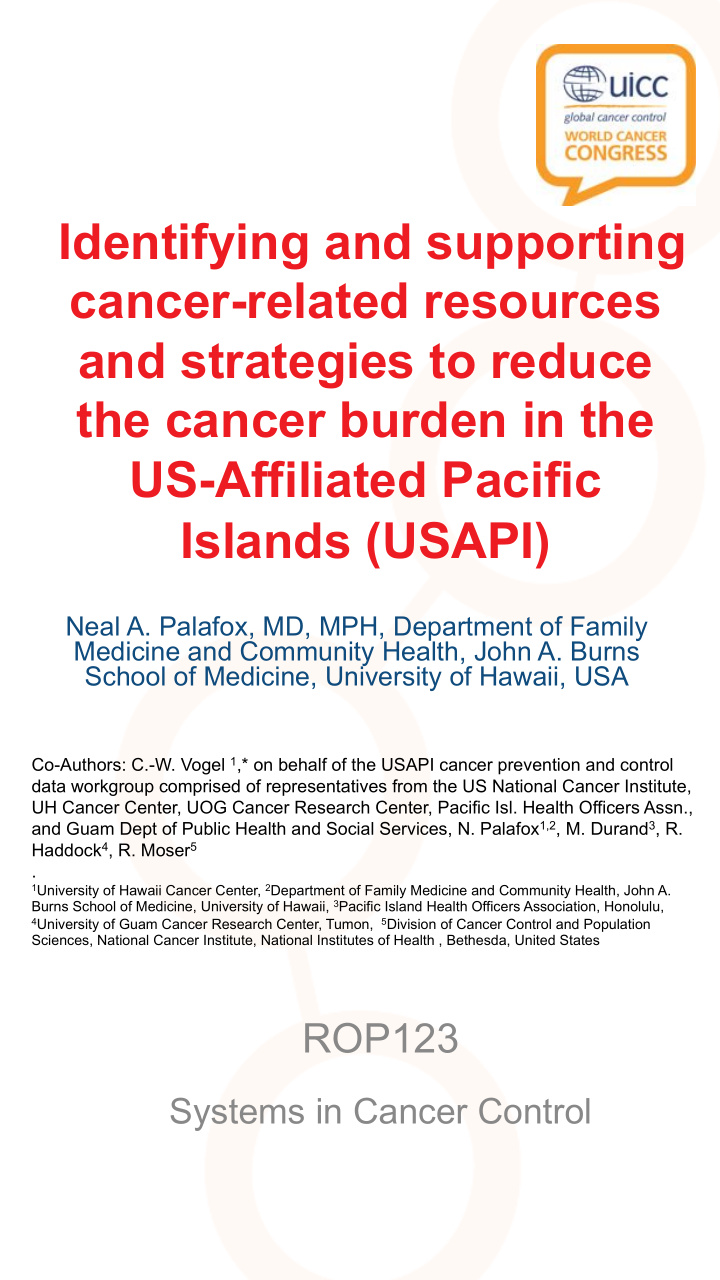



Identifying and supporting cancer-related resources and strategies to reduce the cancer burden in the US-Affiliated Pacific Islands (USAPI) Neal A. Palafox, MD, MPH, Department of Family Medicine and Community Health, John A. Burns School of Medicine, University of Hawaii, USA Co-Authors: C.-W. Vogel 1 ,* on behalf of the USAPI cancer prevention and control data workgroup comprised of representatives from the US National Cancer Institute, UH Cancer Center, UOG Cancer Research Center, Pacific Isl. Health Officers Assn., and Guam Dept of Public Health and Social Services, N. Palafox 1,2 , M. Durand 3 , R. Haddock 4 , R. Moser 5 . 1 University of Hawaii Cancer Center, 2 Department of Family Medicine and Community Health, John A. Burns School of Medicine, University of Hawaii, 3 Pacific Island Health Officers Association, Honolulu, 4 University of Guam Cancer Research Center, Tumon, 5 Division of Cancer Control and Population Sciences, National Cancer Institute, National Institutes of Health , Bethesda, United States ROP123 Systems in Cancer Control
Identifying and supporting cancer- related resources and strategies to reduce the cancer burden in the US- Affiliated Pacific Islands (USAPI) Neal A. Palafox, MD, MPH USAPI span 869,540 sq. miles, 5 time zones, and international date line Disclosure of Interest: 123 Systems in Cancer Control None Declared
Identifying and supporting cancer-related resources and strategies to reduce the cancer burden in the USAPI Neal A. Palafox, MD, MPH Situation: CA burden high, risk factors unique, geography daunting, lacking infrastructure /capacity for screening, treatment, data graveyard, CDC Pacific regional CA registry / NCI SEER Hawaii Jan 2012 : regional cancer control leadership, researchers, funders from HI, USAPI & NCI met to: • Identify cancer control data gaps – cancer risk, prevalence, incidence, mortality and outcome; • Assess current CA registry /data systems, HIS data systems, IT and data collection capacity • Link data collection efforts to integrate with NCD and cancer control plans? • Data system(s) design to match resources, capacity, local need vs funder requirements • Keep /modify current systems? Disclosure of Interest: 123 Systems in Cancer Control None Declared
Identifying and supporting cancer-related resources and strategies to reduce the cancer burden in the USAPI Neal A. Palafox, MD, MPH • Primary Data Sources: Re gional Registry; BRFSS, YRBS, GYTS, STEPS, others • Challenges : data for what purpose, +/- of limiting CA registry variables, adjusting to small population statistics , sustainability and need, variable states of readiness / need across region . • Recommendations : community engagement; core set of region-wide indicators and local health system , data for policy impact, cost effective analysis , coordinate national/ territorial plans ; intervention assessment • Next steps: Regional technical working group and CCPI/Cancer Registry to develop regional comprehensive HIS systems / coordination PLAN. Regional minimum population-based and clinical indicators for NCD epidemic and cancer control. Community buy- in, Regional buy- in, political will Disclosure of Interest: 123 Systems in Cancer Control None Declared
Recommend
More recommend